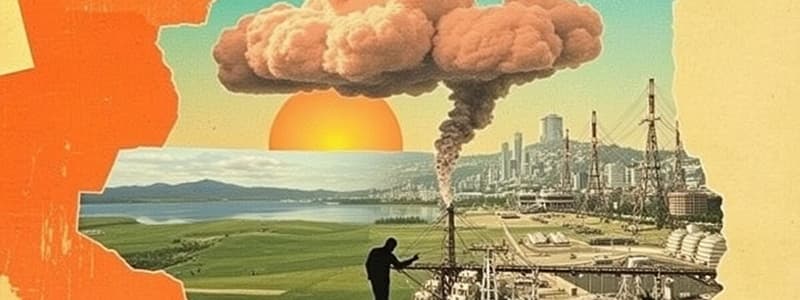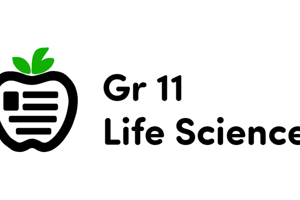Podcast
Questions and Answers
What is the present concentration of CO2 in our atmosphere?
What is the present concentration of CO2 in our atmosphere?
- 280 parts per thousand
- 417 parts per thousand (correct)
- 560 parts per million
- 423 parts per million
- 360 parts per million
There is widespread agreement that to minimize the amount of catastrophic damage due to climate change, the total amount of warming of the Earth's surface since the onset of the Industrial Revolution must be kept to \u22641.5°C. Given current trends in fossil fuels burning and energy policies of industrialized countries, what is the more likely amount of total global warming that will occur in this century?
There is widespread agreement that to minimize the amount of catastrophic damage due to climate change, the total amount of warming of the Earth's surface since the onset of the Industrial Revolution must be kept to \u22641.5°C. Given current trends in fossil fuels burning and energy policies of industrialized countries, what is the more likely amount of total global warming that will occur in this century?
- 4°C or higher as we are on the 'business as usual' emissions track
- This is a trick question as most countries are committed to reaching net zero Carbon emissions (Carbon neutrality) by 2045- 2050.
- between 1.5 and 2.0°C
- between 3.0 and 4.0°C
- between 2.0 and 3.0°C (correct)
Which one of the following statements best describes how the present-day concentration of CO2 in the atmosphere compares to the past before the accelerated use of fossil-fuels?
Which one of the following statements best describes how the present-day concentration of CO2 in the atmosphere compares to the past before the accelerated use of fossil-fuels?
- We don't know because it is not possible to reconstruct how atmospheric CO2 has varied in the very distant past.
- The CO2 concentration in today's atmosphere is higher than the past few 100s of thousands of years but it is rising so slowly that it is negligibly impacting humans and other life on Earth.
- The CO2 concentration in today's atmosphere has started to decline since the Paris Agreement was made in 2015 reflecting that industrial countries have successfully initiated efforts to develop and use more green energy.
- The CO2 concentration in today's atmosphere has stayed near constant over the time since humans evolved.
- The CO2 concentration in today's atmosphere is higher than that of any time in the past 14 million years ago. (correct)
Extreme precipitation events have been increasing in both frequency and intensity over the past 3 decades. Which one of the following is not a reason why this is happening?
Extreme precipitation events have been increasing in both frequency and intensity over the past 3 decades. Which one of the following is not a reason why this is happening?
Which one of the following conditions has maintained the warming at this level and prevented a higher level of warming? That is, given the amount of CO2 that has been added to the atmosphere since the 1860s, higher temperatures would be expected.
Which one of the following conditions has maintained the warming at this level and prevented a higher level of warming? That is, given the amount of CO2 that has been added to the atmosphere since the 1860s, higher temperatures would be expected.
Which one of the following best explains why climate change that is happening now appears to be unprecedented in Earth history when compared to past times of major climate change?
Which one of the following best explains why climate change that is happening now appears to be unprecedented in Earth history when compared to past times of major climate change?
Climate change has played a major role in the 5-fold increase in wildfire activity in CA and the western US over the past few decades. Which one of the following behaviors is not contributing to this increase in wildfire activity?
Climate change has played a major role in the 5-fold increase in wildfire activity in CA and the western US over the past few decades. Which one of the following behaviors is not contributing to this increase in wildfire activity?
Energy and matter are constantly flowing through the different reservoirs of the Earth system. What do we call the atmosphere if more CO2, which is generated by fossil-fuel burning, flows into the atmosphere (and is stored) than flows out (into the ocean or into the biosphere for photosynthesis)? Pick the best answer.
Energy and matter are constantly flowing through the different reservoirs of the Earth system. What do we call the atmosphere if more CO2, which is generated by fossil-fuel burning, flows into the atmosphere (and is stored) than flows out (into the ocean or into the biosphere for photosynthesis)? Pick the best answer.
Which one of the following best describes the Jet Stream?
Which one of the following best describes the Jet Stream?
Are the greenhouse effect and global warming interchangeable terms?
Are the greenhouse effect and global warming interchangeable terms?
That the rate of C emissions to the atmosphere today is minimally an order of magnitude faster than any naturally driven climate change event in Earth's history.
That the rate of C emissions to the atmosphere today is minimally an order of magnitude faster than any naturally driven climate change event in Earth's history.
That rapid climate changes can lead to evolutionary innovation, which could be a welcome consequence of modern climate change.
That rapid climate changes can lead to evolutionary innovation, which could be a welcome consequence of modern climate change.
Flashcards
Current CO2 concentration
Current CO2 concentration
The concentration of carbon dioxide in the atmosphere is currently 423 parts per million.
Climate change limit
Climate change limit
To minimize climate damage, warming should be kept below 1.5°C since the Industrial Revolution.
Likely warming this century
Likely warming this century
Current trends predict between 2.0 and 3.0°C of warming this century.
Past CO2 levels
Past CO2 levels
Signup and view all the flashcards
Extreme precipitation cause
Extreme precipitation cause
Signup and view all the flashcards
Atmospheric warming reason
Atmospheric warming reason
Signup and view all the flashcards
Unprecedented climate change reason
Unprecedented climate change reason
Signup and view all the flashcards
Wildfire increase cause
Wildfire increase cause
Signup and view all the flashcards
Atmosphere as a source/sink
Atmosphere as a source/sink
Signup and view all the flashcards
Greatest heat absorber
Greatest heat absorber
Signup and view all the flashcards
Greenhouse Effect vs. Global Warming
Greenhouse Effect vs. Global Warming
Signup and view all the flashcards
Negative feedback loop
Negative feedback loop
Signup and view all the flashcards
Jet Stream deflection
Jet Stream deflection
Signup and view all the flashcards
Atmospheric circulation origin
Atmospheric circulation origin
Signup and view all the flashcards
Atmospheric circulation fuel
Atmospheric circulation fuel
Signup and view all the flashcards
Jet Stream definition
Jet Stream definition
Signup and view all the flashcards
Jet Stream weakening reason
Jet Stream weakening reason
Signup and view all the flashcards
CO2 vs. O2/N2 absorption
CO2 vs. O2/N2 absorption
Signup and view all the flashcards
Marine desert location
Marine desert location
Signup and view all the flashcards
Marine desert reason
Marine desert reason
Signup and view all the flashcards
Greenland/Arctic melt impact
Greenland/Arctic melt impact
Signup and view all the flashcards
ENSO system
ENSO system
Signup and view all the flashcards
Carbon cycle importance
Carbon cycle importance
Signup and view all the flashcards
Evidence of Carbon Cycle imbalance
Evidence of Carbon Cycle imbalance
Signup and view all the flashcards
Carbon cycle restorer
Carbon cycle restorer
Signup and view all the flashcards
Common Earth climate state
Common Earth climate state
Signup and view all the flashcards
Fossil fuel origin
Fossil fuel origin
Signup and view all the flashcards
PETM lesson
PETM lesson
Signup and view all the flashcards
Methane clathrates relevance
Methane clathrates relevance
Signup and view all the flashcards
Carbon sequestration methods
Carbon sequestration methods
Signup and view all the flashcards
Ice core records lesson
Ice core records lesson
Signup and view all the flashcards
Urban development driver
Urban development driver
Signup and view all the flashcards
California water shortage issue
California water shortage issue
Signup and view all the flashcards
Climate solution for water
Climate solution for water
Signup and view all the flashcards
World's fuel efficiency
World's fuel efficiency
Signup and view all the flashcards
Peak emissions estimate
Peak emissions estimate
Signup and view all the flashcards
2°C limit importance
2°C limit importance
Signup and view all the flashcards
Rapid transition to alternative energy
Rapid transition to alternative energy
Signup and view all the flashcards
Negative emissions technology (non-example)
Negative emissions technology (non-example)
Signup and view all the flashcards
Study Notes
Quiz Questions
- CO2 concentration in atmosphere: 417 parts per million
- Likely total global warming this century: Between 2.0 and 3.0°C
- Comparison of present-day CO2 to past: Higher than any time in the last 14 million years.
Climate Change
- Extreme precipitation events: Increasing in frequency and intensity over the past 3 decades.
- Causes of extreme precipitation: Warmer atmosphere holding more moisture, deforestation, urban heat, intensified water cycles, shifted atmospheric circulation patterns.
- Warming and CO2: 1.2°C average warming since Industrial Revolution.
- Factors preventing further warming: Land absorbing excess heat (half), clouds reflecting heat (over half) ocean absorbing heat (~90%).
- Ice Sheets and Glaciers: Absorbing heat, melting, contributing to sea-level rise.
- Ocean Absorption of Heat: ~90% of excess heat from increased CO2.
Earth System Interactions
- Atmosphere's role (reservoir): Reservoir for CO2 and other gases.
- CO2 increase: When flows of CO2 into the atmosphere are more than flows out.
- Feedback loops: Example: Warmer temperatures lead to increased evaporation, more moisture in the air, and thus, more intense precipitation events.
Modern Climate Change
- Unprecedented conditions: Rate of environmental change is faster than past periods of major change.
- Human Role: Humans now significantly impact environmental systems.
- Wildfire activity in western US: Climate change, warmer temperatures, dry soils, and strong winds related.
- Heat energy transfer: Through different Earth reservoirs.
- How climate change is affecting the atmosphere: Describes how the atmosphere is a reservoir, and what happens when there is a net flow of CO2 into the air.
- Atmospheric composition: O2 and N2 make up most of the atmosphere but don't absorb heat. CO2 (greenhouse gas) absorbs the shorter wavelengths of energy, contributing significantly to warming.
The Greenhouse Effect
- Natural greenhouse effect: Provides 33°C additional warming.
- Enhanced greenhouse effect: Related to fossil fuel burning and rising CO2 levels.
- Interchangeable terms? No, natural greenhouse effect describes natural process, while global warming is the consequence of fossil fuel burning and rising CO2 levels in the atmosphere.
The El Niño-Southern Oscillation (ENSO)
- Definition: An oceanic/atmospheric system in the tropical Pacific.
- Impact: Short-term weather variability in western Americas.
- Conditions: Drought during El Niño events, and wet conditions during La Niña events.
Water Shortage in California
- Water Use: Two-thirds used for agriculture
- Climate solutions: Cloud seeding, recharging aquifers, building high-efficiency dams
Climate Change Thresholds
- Possible impacts of crossing climate thresholds: Accelerated and worsening impacts, loss of marine ecosystems, loss of food sources.
- Methane clathrates: Potentially major climate and environmental change catalyst if they fully melt.
Studying That Suits You
Use AI to generate personalized quizzes and flashcards to suit your learning preferences.




